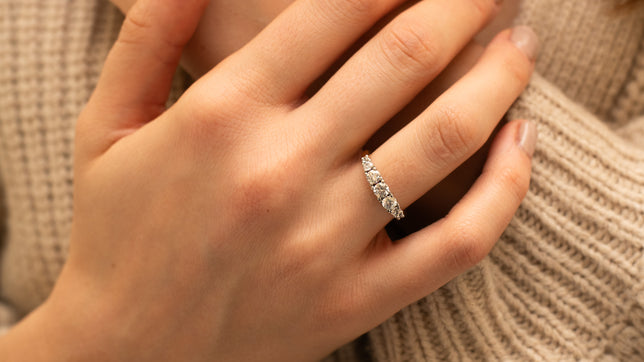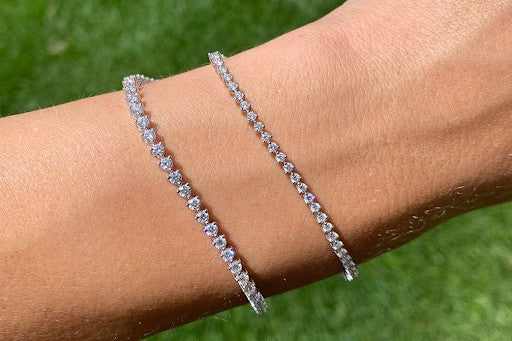Lab grown diamond studs have revolutionized the jewelry industry, offering a sustainable and ethical alternative to traditional mined diamonds. As technology advances, these diamonds have become increasingly popular for their affordability and eco-friendly credentials. In this comprehensive guide, we’ll explore everything you need to know about lab grown diamond studs, from their characteristics and advantages to buying tips and maintenance.
Introduction to Lab Grown Diamonds
Lab grown diamonds, also known as synthetic or cultured diamonds, are created in laboratories using advanced technological processes that replicate the natural diamond-growing environment. Unlike natural diamonds formed over millions of years under the Earth’s crust, lab grown diamonds are produced in weeks to months, utilizing either Chemical Vapor Deposition (CVD) or High Pressure High Temperature (HPHT) methods. These diamonds possess identical physical, chemical, and optical properties to mined diamonds, making them a desirable choice for conscientious consumers.
Advantages of Lab Grown Diamond Studs
Cost-effectiveness: One of the most significant advantages of lab grown diamond studs is their price point. Typically, lab grown diamonds are priced at a fraction of natural diamonds of comparable quality, allowing consumers to purchase larger carat sizes or better quality stones within their budget.
Ethical considerations: Unlike mined diamonds, which often come with ethical concerns related to labor practices and conflicts (such as blood diamonds), lab grown diamonds are conflict-free. They are produced under controlled conditions with strict labor standards, ensuring ethical sourcing.
Environmental impact: Choosing lab grown diamond studs contributes to environmental sustainability. The production of lab grown diamonds generates significantly lower carbon emissions and has minimal impact on natural ecosystems compared to diamond mining. This eco-friendly aspect appeals to environmentally conscious buyers seeking to reduce their carbon footprint.
Quality and Characteristics
Lab grown diamond studs are renowned for their exceptional quality and clarity. They undergo rigorous testing and certification processes to ensure they meet industry standards for brilliance, fire, and durability. When compared to natural diamonds, lab grown diamonds exhibit identical chemical composition and crystal structure, offering consumers a high-quality alternative with no compromise on beauty or durability.
Comparing quality with natural diamonds: Lab grown diamonds are graded using the same 4Cs criteria—cut, color, clarity, and carat weight—as natural diamonds. They are available in a wide range of grades and sizes, catering to diverse preferences and budgets.
Types of lab grown diamonds (CVD vs. HPHT): There are two primary methods used to produce lab grown diamonds. Chemical Vapor Deposition (CVD) involves growing diamonds layer by layer from a carbon-rich gas, while High Pressure High Temperature (HPHT) mimics the natural diamond formation process by subjecting a carbon source to high pressure and temperature. Each method results in diamonds of excellent quality, with slight variations in the growth process affecting their specific characteristics.
Popular Styles and Designs
When it comes to lab grown diamond studs, consumers have a plethora of styles and designs to choose from. From classic solitaire studs to intricate halo designs and trendy geometric shapes, the versatility of lab grown diamonds allows for endless customization options. Whether you prefer a timeless elegance or a contemporary flair, there’s a design to suit every taste and occasion.
Classic vs. modern designs: Classic stud earrings featuring round-cut lab grown diamonds remain a timeless favorite, admired for their simplicity and sophistication. Meanwhile, modern designs incorporate innovative settings and unconventional shapes, appealing to fashion-forward individuals seeking unique jewelry pieces.
Customization options: Many jewelers offer customization services for lab grown diamond studs, allowing customers to select their preferred diamond shape, metal type, and setting style. This customization ensures that each pair of earrings is tailored to reflect the wearer’s personal style and preferences.
Factors to Consider Before Buying:
Budget: Determine your budget range, keeping in mind that lab grown diamonds are generally more affordable than natural diamonds of similar quality.
Quality: Understand the 4Cs—cut, color, clarity, and carat weight—and prioritize what factors are most important to you based on your preferences and budget.
Certification: Opt for lab grown diamonds that come with reputable certification from gemological laboratories such as GIA (Gemological Institute of America) or IGI (International Gemological Institute). Certification ensures the diamond’s authenticity and quality.
Retailer reputation: Choose a trusted retailer known for their expertise in lab grown diamonds and commitment to customer satisfaction. Read reviews and testimonials from other buyers to gauge their reputation.
Return policy and warranty: Check the retailer’s return policy and warranty terms to ensure you have peace of mind in case of any issues with your purchase.
Where to buy lab grown diamond studs: Lab grown diamond studs are available from a variety of sources, including:
Online retailers: Websites specializing in lab grown diamonds often offer a wide selection and competitive pricing. Look for retailers with comprehensive product information and transparent pricing.
Jewelry stores: Many brick-and-mortar jewelry stores now carry lab grown diamond options alongside natural diamonds. Visit stores in your area to see the diamonds in person and consult with knowledgeable staff.
Direct from manufacturers: Some consumers prefer to purchase lab grown diamond studs directly from manufacturers or wholesalers, cutting out middlemen and potentially reducing costs.
Caring for Lab Grown Diamond Studs
To maintain the brilliance and beauty of your lab grown diamond studs, follow these care tips:
Regular cleaning: Clean your earrings regularly using a gentle jewelry cleaning solution and a soft brush to remove dirt and oils that can dull their sparkle.
Avoid chemicals: Remove your diamond studs when using household chemicals or engaging in activities that may expose them to harsh substances.
Storage: Store your diamond studs in a soft cloth pouch or jewelry box to prevent them from scratching or getting tangled with other jewelry.
Comparison with Natural Diamond Studs
Price comparison: Lab grown diamond studs are often more affordable than natural diamond studs of similar size and quality, making them an attractive option for budget-conscious buyers.
Durability and brilliance: Both lab grown and natural diamonds are exceptionally durable and brilliant. Lab grown diamonds exhibit the same fire and sparkle as their mined counterparts.
Certifications and Authentication
Understanding diamond certifications: Look for lab grown diamonds certified by reputable gemological laboratories like GIA or IGI. Certification guarantees the diamond’s authenticity and provides detailed information about its quality characteristics.
Reliable sources for authentication: Purchase lab grown diamond studs from trusted retailers and manufacturers known for their commitment to quality and ethical sourcing practices.
The Future of Lab Grown Diamonds
As technology continues to advance, the popularity and accessibility of lab grown diamonds are expected to grow. Innovations in production methods and increasing consumer awareness of ethical and environmental issues contribute to the expanding market for lab grown diamond jewelry.
Market trends: Demand for lab grown diamonds is on the rise, driven by their affordability, ethical sourcing, and identical quality to natural diamonds.
Technological advancements: Ongoing research and development in diamond synthesis techniques aim to further enhance the quality and diversity of lab grown diamonds available in the market.
Environmental Impact
Choosing lab grown diamond studs supports environmental sustainability by reducing the ecological footprint associated with traditional diamond mining.
Sustainability benefits: Lab made diamonds have a significantly lower environmental impact compared to mined diamonds, contributing to conservation efforts and reducing carbon emissions.
Carbon footprint comparison: Studies indicate that lab grown diamonds generate fewer carbon emissions and require less energy and water during production compared to natural diamonds.
Customer Reviews and Testimonials
Many consumers who have purchased lab grown diamond studs express high satisfaction with their decision. Positive reviews often highlight the affordability, ethical considerations, and stunning beauty of lab grown diamonds.
User experiences: Read customer reviews and testimonials to gain insights into the quality, service, and overall satisfaction from purchasing lab grown diamond studs.
Satisfaction feedback: Customers appreciate the value, craftsmanship, and peace of mind that come with choosing lab grown diamond jewelry.
Conclusion
In conclusion, lab grown diamond studs offer a compelling choice for discerning consumers seeking beauty, quality, and ethical integrity in their jewelry purchases. With their affordability, environmental benefits, and indistinguishable brilliance from natural diamonds, lab grown diamond studs represent the future of sustainable luxury. Whether you’re purchasing your first pair of diamond studs or adding to your jewelry collection, consider the advantages of lab grown diamonds and make a choice that aligns with your values and preferences.




